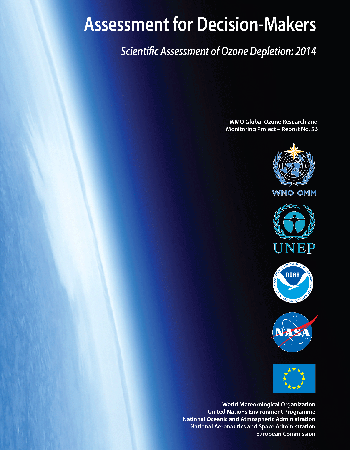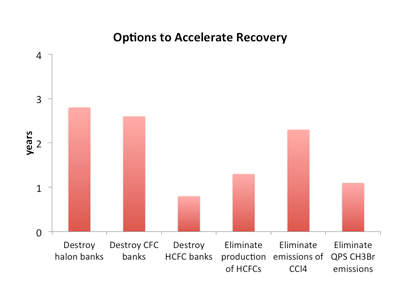Scientific Assessment of Ozone Depletion: 2014
Assessment for Decision-Makers

Executive Summary
This is the Executive Summary of the ADM of the 2014 Ozone Assessment. It contains the policy-relevant major findings of the Assessment's five scientific chapters.
Actions taken under the Montreal Protocol have led to decreases in the atmospheric abundance of controlled ozone-depleting substances (ODSs), and are enabling the return of the ozone layer toward 1980 levels.
- The sum of the measured tropospheric abundances of substances controlled under the Montreal Protocol continues to decrease. Most of the major controlled ODSs are decreasing largely as projected, and hydrochlorofluorocarbons (HCFCs) and halon-1301 are still increasing. Unknown or unreported sources of carbon tetrachloride are needed to explain its abundance.
- Measured stratospheric abundances of chlorine- and bromine-containing substances originating from the degradation of ODSs are decreasing. By 2012, combined chlorine and bromine levels (as estimated by Equivalent Effective Stratospheric Chlorine, EESC) had declined by about 10–15% from the peak values of ten to fifteen years ago. Decreases in atmospheric abundances of methyl chloroform (CH3CCl3), methyl bromide (CH3Br), and chlorofluorocarbons (CFCs) contributed approximately equally to these reductions.
- Total column ozone declined over most of the globe during the 1980s and early 1990s (by about 2.5% averaged over 60°S to 60°N). It has remained relatively unchanged since 2000, with indications of a small increase in total column ozone in recent years, as expected. In the upper stratosphere there is a clear recent ozone increase, which climate models suggest can be explained by comparable contributions from declining ODS abundances and upper stratospheric cooling caused by carbon dioxide increases.
- The Antarctic ozone hole continues to occur each spring, as expected for the current ODS abundances. The Arctic stratosphere in winter/spring 2011 was particularly cold, which led to large ozone depletion as expected under these conditions.
- Total column ozone will recover toward the 1980 benchmark levels over most of the globe under full compliance with the Montreal Protocol. This recovery is expected to occur before midcentury in midlatitudes and the Arctic, and somewhat later for the Antarctic ozone hole.
The Antarctic ozone hole has caused significant changes in Southern Hemisphere surface climate in the summer.
- Antarctic lower stratospheric cooling due to ozone depletion is very likely the dominant cause of observed changes in Southern Hemisphere tropospheric summertime circulation over recent decades, with associated impacts on surface temperature, precipitation, and the oceans. In the Northern Hemisphere, no robust link has been found between stratospheric ozone depletion and tropospheric climate.
Changes in CO2, N2O, and CH4 will have an increasing influence on the ozone layer as ODSs decline.
- As controlled ozone-depleting substances decline, the evolution of the ozone layer in the second half of the 21st century will largely depend on the atmospheric abundances of CO2, N2O, and CH4. Overall, increasing carbon dioxide (CO2) and methane (CH4) elevate global ozone, while increasing nitrous oxide (N2O) further depletes global ozone. The Antarctic ozone hole is less sensitive to CO2, N2O, and CH4 abundances.
- In the tropics, significant decreases in column ozone are projected during the 21st century. Tropical ozone levels are only weakly affected by ODS decline; they are sensitive to circulation changes driven by CO2, N2O, and CH4 increases.
The climate benefits of the Montreal Protocol could be significantly offset by projected emissions of HFCs used to replace ODSs.
The Montreal Protocol and its Amendments and adjustments have made large contributions toward reducing global greenhouse gas emissions. In 2010, the decrease of annual ODS emissions under the Montreal Protocol is estimated to be about 10 gigatonnes of avoided CO2-equivalent emissions per year, which is about five times larger than the annual emissions reduction target for the first commitment period (2008-2012) of the Kyoto Protocol (from the Executive Summary of the Scientific Assessment of Ozone Depletion: 2010)[3].
- The sum of the hydrofluorocarbons (HFCs) currently used as ODS replacements makes a small contribution of about 0.5 gigatonnes CO2-equivalent emissions per year. These emissions are currently growing at a rate of about 7% per year and are projected to continue to grow.
- If the current mix of these substances is unchanged, increasing demand could result in HFC emissions of up to 8.8 gigatonnes CO2-equivalent per year by 2050, nearly as high as the peak emission of CFCs of about 9.5 gigatonnes CO2-equivalent per year in the late 1980s[4].
- Replacements of the current mix of high-Global Warming Potential (GWP) HFCs with low-GWP compounds or not-in-kind technologies would essentially avoid these CO2-equivalent emissions.
- Some of these candidate low-GWP compounds are hydrofluoro-olefins (HFOs), one of which (HFO- 1234yf) yields the persistent degradation product trifluoroacetic acid (TFA) upon atmospheric oxidation. While the environmental effects of TFA are considered to be negligible over the next few decades, potential longer-term impacts could require future evaluations due to the environmental persistence of TFA and uncertainty in future uses of HFOs.
- By 2050, HFC banks are estimated to grow to as much as 65 gigatonnes CO2-equivalent. The climate change impact of the HFC banks could be reduced by limiting future use of high-GWP HFCs to avoid the accumulation of the bank, or by destruction of the banks.
Additional important issues relevant to the Parties to the Montreal Protocol and other decision-makers have been assessed.
- Derived emissions of carbon tetrachloride (CCl4), based on its estimated lifetime and its accurately measured atmospheric abundances, have become much larger than those from reported production and usage over the last decade.
- As of 2009, the controlled consumption of methyl bromide declined below the reported consumption for quarantine and pre-shipment (QPS) uses, which are not controlled by the Montreal Protocol.
- Increased anthropogenic emissions of very short-lived substances (VSLS) containing chlorine and bromine, particularly from tropical sources, are an emerging issue for stratospheric ozone. The relative contribution of these emissions could become important as levels of ODSs controlled under the Montreal Protocol decline.
- As the atmospheric abundances of ODSs continue to decrease over the coming decades, N2O, as the primary source of nitrogen oxides in the stratosphere, will become more important in future ozone depletion.
- Emissions of HFC-23, a by-product of HCFC-22 production, have continued despite mitigation efforts.
- While ODS levels remain high, a large stratospheric sulfuric aerosol enhancement due to a major volcanic eruption or geoengineering activities would result in a substantial chemical depletion of ozone over much of the globe.
While past actions taken under the Montreal Protocol have substantially reduced ODS production and consumption, additional, but limited, options are available to reduce future ozone depletion.

Emissions from the current banks are projected to contribute more to future ozone depletion than those caused by future ODS production, assuming compliance with the Protocol.
- Possible options to advance the return of the ozone layer to the 1980 level (analyses based on midlatitude EESC) are shown graphically. The cumulative effect of elimination of emissions from all banks and production advances this return by 11 years.
[3] GWP-weighted emissions, also known as CO2-equivalent emissions, are defined as the amount of gas emitted multiplied by its 100-year Global Warming Potential (GWP). Part of the effect of ODSs as greenhouse gases is offset by the cooling due to changes in ozone.
[4] This is equivalent to about 45% of the fossil fuel and cement emissions of CO2 in the late 1980s.